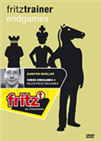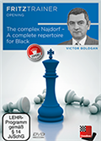ChessBase Magazine 190 Review
As I write these lines, the 7th Sinquefield Cup Tournament is in progress. After the poor result in St. Louis Rapid & Blitz Tournament (he came only fifth) Magnus Carlsen is determined to prove himself here. But success has eluded him so far, and he remains bogged down by draws.
However, form is temporary and class is permanent. One only has to look at the world champion’s games in this magazine and see how well he plays. As for his rivals, they are also in hot pursuit of the title. Currently, they are in the race for the Candidates’. The present “leader” (if you may say so) among them is Ian Nepomniachtchi.
Nepomniachtchi's gains in the Grand Prix
In May this year Ian won the FIDE Grand Prix Tournament in Moscow, a qualifying event for the Candidates’. This was a strong event with GMs like Aronian, Karjakin and Grischuk competing. How he managed to get ahead of them all is a story in itself. All the games from the tournament are included in this issue and Nepomniachtchi himself analyses his encounter with Aronian.

Andrey Filatov, President of the Russian Chess Federation, makes the first move | Photo: World Chess
The annotations are a revelation and offer an insight into the mind of a grandmaster. It is only for reasons of space that I am not able to reproduce them here. However, there is one critical moment on which he is a bit opaque. He writes, Black made the wrong move and it is only later that we understand why. Here is the position with pawns on both sides racing to queen.
 The third part of the endgame series tackles queen endings, rook against minor pieces, queen against rook and queen against two rooks. Queen endings are not nearly as mysterious as they appear at first sight. Knowing a few rules of thumb and principles will make things very much easier for you.
The third part of the endgame series tackles queen endings, rook against minor pieces, queen against rook and queen against two rooks. Queen endings are not nearly as mysterious as they appear at first sight. Knowing a few rules of thumb and principles will make things very much easier for you.
Over 7 hours video training.
Readers should give it a try and see what would be the best outcome for Black. What was wrong with Aronian? After the tournament he confessed, he had not sufficiently prepared for his openings. In this game he was surprised by Nepomniachtchi’s novelty and put up a big fight with a mix of imagination and desperation. To no avail in the end.
It was not easy for seasoned campaigners, Nakamura, Svidler and Mamedyarov either. Each of them was eliminated in the knockout. Among the rest Radoslaw Wojtaszek played well and was only let down by nerves in the end against Nepomniachtchi.
As for the young, Duda and Dubov, time is on their side and I am sure we shall hear from them again.
Apart from Grand Prix Moscow, this issue includes three other events, all of them won by Carlsen. Magnus easily dominated the Grenke and Gashimov Memorial Tournaments. Peter Heine Nielsen has annotated his games with Karjakin, Grischuk and Svidler here. The last of them offered much mirth, with Svidler sportingly allowing a pawn mate (video).
Magnus versus Maxime
Magnus, however, had a rocky ride in Côte d’Ivoire Rapid & Blitz. While he came first in the final standings ahead of Hikaru Nakamura and Maxime Vachier-Lagrave, he suffered in blitz. MVL beat him with both white and black pieces and indeed came first in blitz.

All lenses on Magnus vs MVL | Photo: Lennart Ootes / Grand Chess Tour
Here is the win from the second round:
 When choosing an opening repertoire, there are days when you want to play for a win with Black, when you want to bear down on your opponent’s position with a potentially crushing attack. The Najdorf is perfect for just such occasions. Strategy, combinations, attack and defence, sacrifices and marvellous manoeuvres — exciting chess is all about the Najdorf!
When choosing an opening repertoire, there are days when you want to play for a win with Black, when you want to bear down on your opponent’s position with a potentially crushing attack. The Najdorf is perfect for just such occasions. Strategy, combinations, attack and defence, sacrifices and marvellous manoeuvres — exciting chess is all about the Najdorf!
This game attracted a lot of attention | Photo: Lennart Ootes / Grand Chess Tour
A terrific battle! MVL is one of the few players who can take on the world champion in blitz. In fairness to Magnus he played some fine games in this event. So did other specialists in speed chess like Karjakin, Nakamura and Nepomniachtchi. It’s worthwhile looking at these games. You also learn about handling the clock in time pressure.
Who has the last laugh here?
This brings me to the rest of the magazine. There are as many as 12 opening surveys ranging from the Caro-Kann to the King’s Indian with 60 annotated games. The authors include Rainer Knaak, Lars Schandorff, Robert Ris and others. Among them Romain Edouard’s work deserves special mention. The following position is from his analysis. White has won the exchange and is also a pawn up. Can Black save himself?
I have an issue with Alexey Kuzmin, one of the authors in this issue. He manages to get the name of a young grandmaster wrong. It should read Vidit Santosh Gujarathi and not the other way round. Dr. Santosh Gujarathi, his father is a well-known doctor in Nashik and runs a migraine clinic. Vidit’s victims are welcome!
Summing up
Apart from these surveys, there are regular exercises in opening traps, middle game tactics and endgames. With this issue the magazine has introduced a new feature: Letters to the Editor. So feel free to ask questions and offer comments.
There is much else in this DVD that deserves to be explored. In all, there are about 1200 games of which 90 are annotated. The commentators include Anand, Caruana and Wojtaszek among others. A major contribution is made by Michal Krasenkow who has annotated as many as 10 games. .
Note: This year the Magazine has come up with a new format for its contents. I still prefer the old format, though. Gen.Next, however, is entitled to a different opinion. Your move!
Analyses by Caruana, Nepomniachtchi, Anand, Kashlinskaya, Wojtaszek, Navara, Meier, Keymer etc. from recent top-class tournaments. Videos by King, Trent, Pelletier and Marin. 12 opening articles with new repertoire ideas and much more!
Links
























